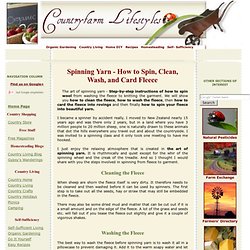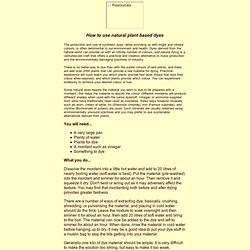

How A Spinning Wheel Works. Spin Yarn On A Wheel - Absolute Beginner Lesson! Spinning Wool Yarn - How To Spin, Clean, Wash, & Card Fleece. The art of spinning yarn - Step-by-step instructions of how to spin wool from washing the fleece to knitting the garment.

We will show you how to clean the fleece, how to wash the fleece, then how to card the fleece into rovings and then finally how to spin your fleece into beautiful yarn. I became a spinner by accident really. I moved to New Zealand nearly 15 years ago and was there only 2 years, but in a land where you have 3 million people to 20 million sheep, one is naturally drawn to these animals that dot the hills everywhere you travel out and about the countryside. I was invited to a spinning class and it only took one meeting to have me hooked. I just enjoy the relaxing atmosphere that is created in the art of spinning yarn. Cleaning the Fleece When sheep are shorn the fleece itself is very dirty. There may also be some dried mud and matter that can be cut out if it is a small amount and on the edge of the fleece. Washing the Fleece Carding the Wool Spinning the Wool.
How To Look After Your Spinning Wheel. S Focus on Spinning. Spinning, Processing & Dyeing Videos. Spinning Guilds. Early American Weaving & Dyeing (Dover Americana) How To Use Plant Based Dyes - Steward Community Woodland. The production and use of synthetic dyes, while providing us with bright and vibrant colours, is often detrimental to our environment and health.

Dyes derived from the natural world can provide us with an infinite number of colours, and natural dying is a centuries-old craft that offers a practical and creative alternative to mass production and the environmentally damaging practises of industry. There is no better way to dye than with the subtle colours of wild plants, and there are well over 2000 plants that can provide a raw material for dying. Practical experience will soon teach you which plants provide fast dyes (those that hold their colour when washed), and which plants provide which colour. You can experiment endlessly to achieve your desired colour or hue.
Some natural dyes require the material you wish to dye to be prepared with a 'mordant', this helps the material to absorb the colour. You will need... What you do... Generally one kilo of dye material should be ample. Dyeing Fibers Links From Straw Into Gold. Dye - Dyes From Plants - Pioneer Thinking. Did you know that a great source for natural dyes can be found right in your own back yard!

Roots, nuts and flowers are just a few common natural ways to get many colors. Yellow, orange, blue, red, green, brown and grey are available. Go ahead, experiment! Gathering plant material for dyeing: Blossoms should be in full bloom, berries ripe and nuts mature. Remember, never gather more than 2/3 of a stand of anything in the wild when gathering plant stuff for dying. To make the dye solution: Chop plant material into small pieces and place in a pot. Getting the fabric ready for the dye bath: You will have to soak the fabric in a color fixative before the dye process. Color Fixatives: Salt Fixative (for berry dyes) 1/2 cup salt to 8 cups cold water Plant Fixatives (for plant dyes) 4 parts cold water to 1 part vinegar Add fabric to the fixative and simmer for an hour. Dye Bath: Place wet fabric in dye bath.
NOTE: It’s best to use an old large pot as your dye vessel. Shades of ORANGE Shades of PINK. Vegetable Dye Color Chart - Flickr.